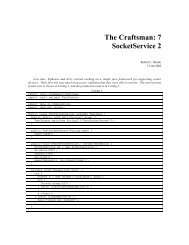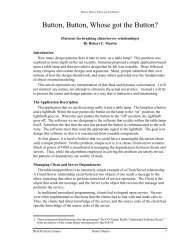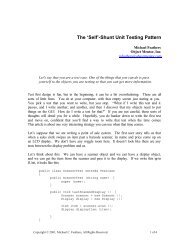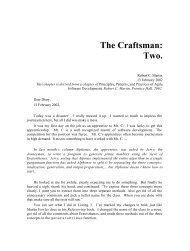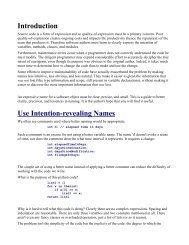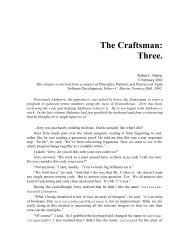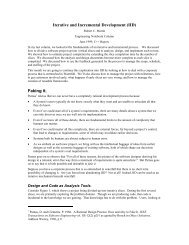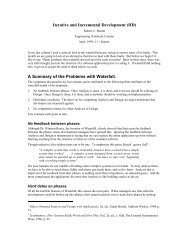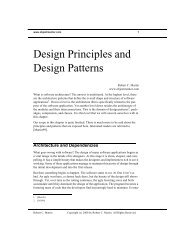Working Effectively With Legacy Code (PDF) - Object Mentor
Working Effectively With Legacy Code (PDF) - Object Mentor
Working Effectively With Legacy Code (PDF) - Object Mentor
Create successful ePaper yourself
Turn your PDF publications into a flip-book with our unique Google optimized e-Paper software.
<strong>Working</strong> <strong>Effectively</strong> <strong>With</strong> <strong>Legacy</strong> <strong>Code</strong>Michael Feathers<strong>Object</strong> <strong>Mentor</strong>, Inc.mfeathers@objectmentor.comLast Change: April 9, 2002Over the past fifteen years, much has been written about object oriented design and teamdevelopment processes. The unfortunate thing is that much design and process adviceassumes that your project is a blank page. In actuality, greenfield projects are noticablyrare. Most projects carry some amount of legacy code. In many new developmentefforts, the amount of legacy code will overwhelm the amount of new code by factors of100 to 1, or 1000 to 1. Needless to say, you can't work very fast with a legacy code base.Work is often much slower, but you can speed it up if you establish a strategy to dealwith your existing code and mitigate risk as new development goes forward. In thispaper, I'll outline a strategy that can be used to work with legacy code. But first let'sestablish some background.What is <strong>Legacy</strong> <strong>Code</strong>?A few years ago, I asked a friend how his new client was doing. He said "they're writinglegacy code." I knew what he was saying immediately, and the idea hit me like a ton ofbricks. After all, there is an emotionally neutral definition of "legacy code." <strong>Legacy</strong>code is code from the past, maintained because it works. But, for people who deal with itday in and day out "legacy code" is a pandora's box: sleepless nights and anxious daysporing through bad structure, code that works in some incomprehensible way, daysadding features with no way of estimating how long it will take. The age of the code hasnothing to do with it. People are writing legacy code right now, maybe on your project.The main thing that distinguishes legacy code from non-legacy code is tests, or rather alack of tests. We can get a sense of this with a little thought experiment: how easy wouldit be to modify your code base if it could bite back, if it could tell you when you made amistake? It would be pretty easy, wouldn't it? Most of the fear involved in makingchanges to large code bases is fear of introducing subtle bugs; fear of changing thingsinadvertently. <strong>With</strong> tests, you can make things better with impunity. To me, thedifference is so critical, it overwhelms any other distinction. <strong>With</strong> tests, you can makethings better. <strong>With</strong>out them, you just don’t know whether things are getting better orworse.Copyright © 2002, Michael Feathers, All Rights Reserved 1 of 12
The key to working effectively with legacy code is getting it to a place where it ispossible to know that you are making changes one at a time. When you can do that, youcan nibble away at uncertainty incrementally. The tests that you use to do this are a bitdifferent from traditional tests. I like to call them test coverings.Test CoveringsA ''test covering'' is a set of tests used to introduce an invariant on a code base. Thesetests are a bit different from the ones that are most often talked about in ExtremeProgramming. For one thing, they tend to cover the behavior of a set of classes ratherthan just a class and its immediate collaborators. For another, they tend to cover somesmall area of a system just well enough to provide some ''invariant'' that lets us knowwhen we’ve changed the behavior of our system. The key thing is that correct behavioris defined by what the set of classes did yesterday, not by any external standard ofcorrectness.In a design driven from the beginning using tests, the tests serve a couple of purposes.They seed the design, they record the intentions of the designers, and they act as a largeinvariant on the code. In legacy code, it would be great to have tests which do all threefor us, but nothing is free. We can produce the most value working backwards: build theinvariant first, then refactor to make the code clear. If we discover that the results fromour test covering are not what the system should calculate, we can deal with that as aseparate issue. The primary goal is to get that invariant before refactoring or adding newbehavior.Your approach to test coverings can vary quite a bit depending upon whether your systemis in production or not. Systems that are already deployed often require far more diligentcovering because the cost of errors is significantly higher. Typically, there are userswho've grown to depend upon the current behavior of the system. On the other hand, if asystem has never been deployed and there is quite a bit of legacy code, i.e, code withouttests, you can often refactor with relative impunity, bringing things under test as you go.It is quite literally the case that no one "knows" whether the code is correct or not. Thenumber of bugs that you introduce by doing some initial refactoring without a strong testcovering, may be marginal compared to the number of bugs that you'll discover as youbring code under test. Essentially, you have to make a judgement call about how muchrisk you are willing to assume as you bring the system under test.Now, let’s talk about how to move forward.<strong>Legacy</strong> Management StrategyBy itself, legacy code doesn't hurt anything. As long as it works, it only becomes painfulwhen you have to make modifications. Fortunately, the first steps you have to take towork effectively with legacy code also make it easier to clean things up.Copyright © 2002, Michael Feathers, All Rights Reserved 2 of 12
The general legacy management strategy is:1. Identify change points2. Find an inflection point3. Cover the inflection pointa. Break external dependenciesb. Break internal dependenciesc. Write tests4. Make changes5. Refactor the covered code.Identify Change PointsWhen you have to make a change to legacy code, the first step is to figure where thechanges will need to be made. There really isn't much to say about this except that theamount of work involved varies with the degree of sickness in the code. Some changesmay require a lot of work in different areas of the system. However, if there are multipleways of making the changes, and you do not yet have test coverings in place, there aredividends for choosing the way which requires the fewest changes. In other words, the"right" way to add a change may not be the best initial choice. Why would this be? Forthe most part it is because bringing large areas of code under coverage can take anincredible amount of time. Fortunately, once you bring an area of code under test, it iseasier to deal with the next time. Over time, the “islands” of coverage that you create inyour code base will merge and you can refactor the classes in them to consolidate further.Find an Inflection PointAfter you’ve found the places in the code that you need to change, the next thing youneed to do is find an inflection point. An inflection point is a narrow interface to a set ofclasses. If anyone changes any of the classes behind an inflection point, the change iseither detectable at the inflection point, or inconsequential in the application.Let’s use a variation of the video store example that Martin Fowler developed in his bookRefactoring [1]. We would like to make changes to the way that videos are priced.Customer is an inflection point for Rental, Movie, Pricer, and all of their subclasses. It isan inflection point, because there is no way that any behavioral change in Rental, Pricer,and Movie or any of their subclasses can change the behavior of the application withoutgoing through it. More specifically, the rest of the system receives state changes throughmethods on Customer. If we have comprehensive enough tests at the Customer level, wecan be reasonably certain that we are not changing other things when we refactor or addthings behind the inflection point.Copyright © 2002, Michael Feathers, All Rights Reserved 3 of 12
CustomerViewCustomer*Rental1Movie1ReportCustomerMonthlyReportNonTaxedRentalPricerNewReleasePricerDefaultPricerLet's imagine another scenario. Suppose that we introduce a class named Inventorywhich maintains a collection of all the movies in the system and prints a report.Inve ntoryCustomerView+ printReport*Customer*Rental1Movie1ReportCustomerMonthlyReportNonTaxedRentalPricerNewReleasePricerDefaultPricerOnce we've done that, Customer is still an inflection point for Rental, but not for Pricersor Movies. Any change that we make to Rental must go through Customer to beeffective in the system. But, if we start to make changes to Pricer, those changes couldbe propagated to the rest of the system via Inventory as well as Customer.Copyright © 2002, Michael Feathers, All Rights Reserved 4 of 12
Inflection points are not solely determined by physical dependency, but rather by the waythat effects are propagated at run time in software. To see this, imagine that Customerdid not have any methods which returned values. The dependency picture above wouldbe the same even though CustomerMonthlyReport and CustomerView would have to getinformation about the customer in some other way.When you try to find inflection points, move outward from the places you are going tochange the software. Look for a narrow interface. It could be one class or several. Aswell, it is important not to depend on preexisting UML diagrams as you do this.Diagrams rarely show all of the users of particular classes.Cover Inflection PointCovering an inflection point involves writing a tests for it. The hard part of this is gettingyour legacy code to compile in a test harness. You often have to break dependencies.In the case of the little example system above, we'd like to get a Customer object in aharness so that we can write some tests which cover its functionality. The easiest thing isto just try to create a new instance of the class. At that point, we'll discover what we needto provide it to get it to work properly. There are two types of dependencies which wewill run into immediately: external dependencies and internal dependencies. Externaldependencies are objects which we have to provide to setup the object we are creating.Often they are constructor parameters, or objects which we have to set at the object’sinterface. In the case of Customer, it seems that we will have to provide a CustomerViewobject when we create it, but do we really?Breaking External Dependencies<strong>Object</strong>s talk to other objects to get work done. This can be pretty distressing if you wantto separate out a cluster of objects to make a test covering. Fortunately, you can easilysever the connection between any two objects. This is known as dependency inversion,and here is how you do it:class CustomerView{private Customer _customer;public void setCustomer (Customer customer) {_customer = customer;}public void update() {nameWidget.setText(_customer.getName());}}...Copyright © 2002, Michael Feathers, All Rights Reserved 5 of 12
class Customer{public Customer(CustomerView view) {_view = view;_view.setCustomer(this);}...}As we can see, Customer objects have a direct dependency on CustomerViews. We needa customer view whenever we create a customer. Actually, the situation is far worse thanthat. We need a customer view and we also need everything that a customer view needs,transitively. If customer view has a non-trivial setup, we could spend hours huntingthrough chains of references, finding more thing to create just so that our tests will beable to run.The problem is that Customer depends on a concrete class, worse it is one we don't evencare about when testing. For our test covering, we are just interested in providing valuesto customer objects and asking for results through the customer interface.We can break the dependency by changing CustomerView into an interface and renamingthe original class:interface CustomerView{void setCustomer(Customer customer);void update();}class StandardCustomerView implements CustomerView{private Customer _customer;public void setCustomer (Customer customer) {_customer = customer;}public void update() {nameWidget.setText(_customer.getName());...}}...Copyright © 2002, Michael Feathers, All Rights Reserved 6 of 12
class Customer{public Customer(CustomerView view) {_view = view;_view.setCustomer(this);}...}Now, we can create a customer object in our test without much trouble:Customer customer = new Customer(new CustomerView () {public void setCustomer(Customer customer) {}public void update() {}});The bodies of the methods are empty because we just don't care what happens to the viewas we test through a Customer object.Breaking Internal DependenciesInternal dependencies are a little trickier to deal with. When the class we want to covercreates its own objects internally, sometimes the best thing that you can do is subclass tooverride the creations.Imagine that customer creates an archiver that records actions taken against its interface.We want to put Customer under test, but we don't want to have a dependency on theArchiver class. Archiving is a real performance hit and our tests would run abysmallyslow if we did it. Unfortunately, Customers create archivers in the constructor:class Customer{private Archiver _archiver;public Customer(CustomerView view) {...archiver = new FileArchiver(customerPersistenceName);...}}Copyright © 2002, Michael Feathers, All Rights Reserved 7 of 12
One way around this is to extract the creation of the archiver. We can create a methodnamed makeArchiver and add it to the customer class:class Customer{private Archiver archiver;}public Customer(CustomerView view) {...archiver = makeArchiver();...}protected Archiver makeArchiver() {return new FileArchiver(customerPersistenceName);}Now, to create a customer in our test, we can do this:class TestingCustomer extends Customer{protected Archiver makeArchiver() {return new NullArchiver();}}Customer customer = new TestingCustomer(new CustomerView () {public void setCustomer(Customer customer) {}public void update() {}});Here we've introduced a new class TestingCustomer which just overrides themakeArchiver method. When we create a TestingCustomer, we can be sure that wehaving something which behaves like the Customer in our tests, but with one tinydifference: it doesn't use a real archiver. We can use it to test everything past theinflection point.The makeArchiver method in TestingCustomer is a bit special too. It creates aNullArchiver. All NullArchiver is, is a class which implements the Archiver interfaceCopyright © 2002, Michael Feathers, All Rights Reserved 8 of 12
and provides bodies that don't actually do anything. We could create aNullCustomerView class also so that we don't have to create an anonymous inner classwhen we test:Customer customer = new TestingCustomer(new NullCustomerView ());Generally, I create Null classes whenever I end up duplicating code in anonymous innerclasses. They can be very handy as you move forward in testing. If you need to tailor afew methods for use in a particular test, you can override only those methods, assuredthat the rest do nothing.If you are tempted to use this strategy in C++, be leery of the fact that when you call avirtual function in a base class constructor, the method that is executed is the one in thebase class, not the one you’ve overridden in the derived class. To get around this in C++,you either have to use two stage initialization or lazy-initializaton. In two-stageinitialization, you add an initialize () method to Customer and make sure that all clients ofCustomer call initialize (). Then you move the creation of archiver to the initializemethod and extract the makeArchiver method. In lazy-initialization, you write a getterfor the archiver field and make sure that all accesses of the archiver go through the getter.Then you use an internal test to determine whether it is time to create the archiver.class Customer{protected:Archiver *archiver;Archiver *getArchiver() {if (archiver == 0)archiver = new FileArchiver(customerPersistenceName);return archiver;}public:Archiver() : archiver(0) { … }…};class TestingCustomer : public Customer{protected:Archiver *getArchiver() {if (archiver == 0) archiver = new NullArchiver;return archiver;}};Copyright © 2002, Michael Feathers, All Rights Reserved 9 of 12
Subclassing is a great strategy when you need to override the creation of objects, butwhat do you do when you have internal dependencies on things that you haven’t created?These dependencies are affectionately known as global variables. From a testingperspective, it isn’t the fact that these variables are global that is a problem as much asthe fact that they are variables. Let’s think about this in terms of effects.When we were discovering inflection points, we were trying to find narrow parts of thedesign which channel all of the effects of set of classes. When we put the classes for thatinflection point in a test harness, we have to faithfully set up all of things those classesdepend upon. Why? Well, it isn’t just a matter of physical dependencies. The things wedepend upon must act as they would in production code. The problem with globalvariables is that prior to any test run, you must provide them with a good known initialstate. Often that requires a lot of tedious work. If you forget to set up particularvariables, you can easily have tests which bleed state from one execution to another. Youmay not be testing what you think you are testing.In OO systems, global variables often show up as instances of the singleton pattern or justas static data in classes. Not all singletons are on the same footing as global variables. Inparticular, singletons which do not affect the functional behavior of an application(caches, factories), can behave well as internal dependencies.Writing TestsOnce we are able to put the objects of an inflection point in a test, we have to go throughthe process of placing some sort of an invariant on the code guarded by the inflectionpoint.Remember our key assumption here: code changes behind the inflection point can nothave effect in the system without passing through the inflection point. If that is true, thenwe can start to write tests for using the interfaces of the inflection point. In the videostore example, we would write tests against the Customer interface.How do you find good covering tests? If the interface is narrow enough, you can startwith boundary values to see how the subsystem behaves at the edges. Remember thatcorrectness, at this point in time, is just how the system behaves currently. Another thingthat you can do is take the code behind the inflection point and start to change it to seehow values change at the interface. Often this can give you ideas for additional tests.Needless to say, when you do this you should always be very clear about where thegolden, ostensibly correct copy of the code is.One thing that I haven’t done, but I’m eager to try, is automated test generation. Sincethe goal is simply to characterize the existing behavior of the code and sense whenchanges invalidate it, a set of scripts can be used generate sample data. While the casesCopyright © 2002, Michael Feathers, All Rights Reserved 10 of 12
that you generate that way may not be the ones you would like to keep in the system overits lifetime, they can be used to keep an invariant.Make ChangesThis is programming, pure and simple. Once you have test coverings over the changeareas, you can incrementally make your changes. Take care to run your tests often. Trywriting tests first, for the changes that you make. After you make changes, add additionaltests to bolster your work.Refactor Covered <strong>Code</strong>Once you have a test covering in place, you have a wonderful opportunity to clean upyour design. At times, it can be hard to figure out how to take advantage of it;particularly if the code is very poorly structured. The hallmarks of this sort of code are:large classes with extremely large methods.The important thing to realize is that getting the covering in place is the hard work. Youcan refactor on demand as you make changes. However, I’ve discovered that therefactoring that I do on legacy code tends to follow a little pattern. If I want to start toclarify some covered code, I first start by doing the extract method [1] refactoring overand over again. Then, I start to pay attention the pattern of usage in the class. Are theregroups of methods which use the other methods and data in the class? If there are, I mayhave found a place where the class can be split. At that point, I use the extract class [1]refactoring. Being very sensitive to these patterns of use in class can make a bigdifference.As you refactor, remember to keep writing tests. Even though test coverings can remainas part of your test suite, it can be easy to forget they are there, or worse, believe that theytest things that they do not. The best thing that you can do as you refactor is get into thehabit of refactoring into tests. Refactoring into tests is a little like test first design. In thecase of extract method, you look at a large method, imagine a portion you’d like toextract, write a test for it, then you extract the method to make the test pass. When yourefactor into a test, you are forcing yourself to consider all of the decoupling that youneed to do to write good tests. Once you have the extraction, you can cover it further bywriting more tests.ConclusionThe strategy that I’ve outlined works for a wide variety of changes, however there aresome caveats. Sometimes the only decent inflection point that you can find for a set ofclasses is the system boundary. In some applications, the system boundary can be prettywide: it encompasses the GUI, calls to other external libraries, the database, etc. In thosecases, the best way to get an invariant is to start writing what Steve McConnell calls“smoke tests” against the rest of the system [2].Copyright © 2002, Michael Feathers, All Rights Reserved 11 of 12
One promising avenue for Java programmers is the development of AspectJ [3]. <strong>With</strong>AspectJ, you can write code that will intercept calls in an existing application withoutmodification. You can use it to log results. Then, when you refactor, you can run againand see if the new set of results differs from the old one. If it does, you’ve modifiedbehavior. It’s time to roll back and start over again.Another issue that has come up as I’ve explained inflection points is the question of howprevalent they are in legacy code Paradoxically, I’ve found that they are often easier tofind in poorly structured code than in well-structured code. In poor code, there isn’t ahigh degree of internal reuse so it is often pretty easy to find somewhat localized classusage. When you start refactoring code and eliminating duplication, infection points cango away. It may seem that we are working at cross purposes, but once unit tests are inplace, scaffolding each class, inflection points don’t really do much for us. It is odd, butit is kind of nice that there is one quality of poor design that helps us when we want toimprove it![1] Fowler, Martin Refactoring: Improving the Design of Existing <strong>Code</strong>, Addison-Wesley1999[2] McConnell, Steve Rapid Development: Taming Wild Software DevelopmentSchedules, Microsoft Press 1996[3] AspectJ website: www.aspectj.orgCopyright © 2002, Michael Feathers, All Rights Reserved 12 of 12



